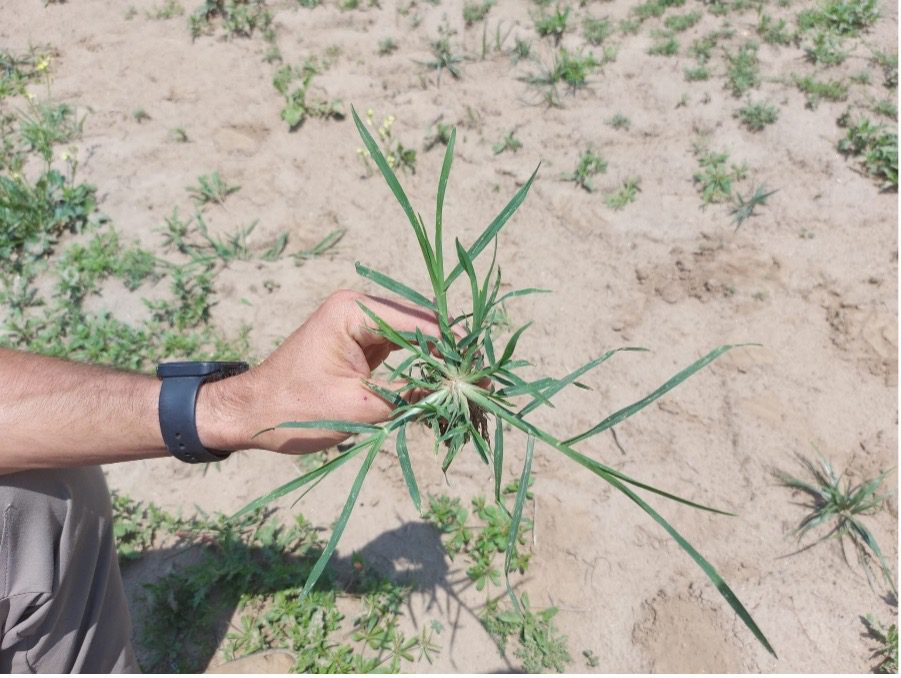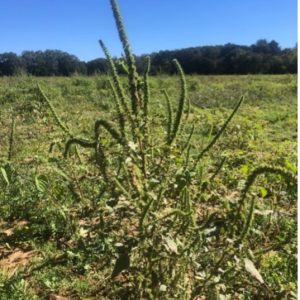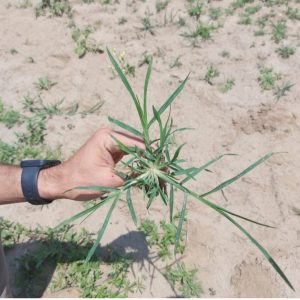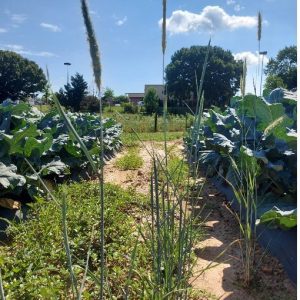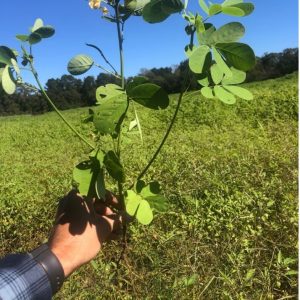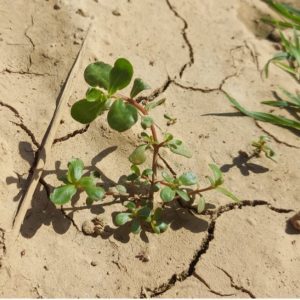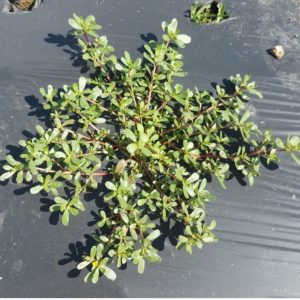Crop Production

Weed management expenses can be one-third of an organic vegetable grower’s production cost. Knowing the common weeds to look for and how to control them can help a grower target spending for maximum efficiency, improve crop yield, and increase profits.
Proper weed management is always challenging for growers in Alabama, particularly for organic growers. Once weeds are established, they compete for a crop’s water and nutrients. To be successful, growers must create a weed management plan, beginning with weed plant identification.
Cutleaf Groundcherry (Physalis angulata)
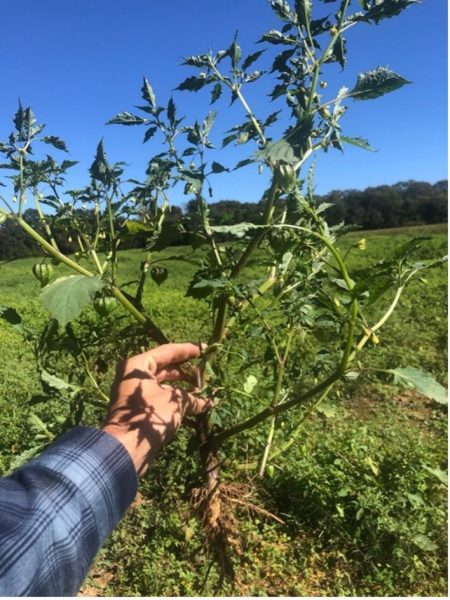
Figure 1. Cutleaf groundcherry plant
Cutleaf groundcherry is a summer weed found in most southeastern United States agricultural areas, including Alabama. Cutleaf groundcherry belongs to the Solanaceae family, the same family as tomatoes, peppers, and eggplant, and can grow up to 3 feet tall. The leaves have a spearhead shape. The flowers are yellow and hang upside down (figure 1). Thin leaves surround the fruit, called the calyx, which turns brown as it ripens.
Although shade tolerant, cutleaf groundcherry prefers sunlit areas. It is a common weed in regularly fertilized fields with high soil moisture availability. Cutleaf groundcherry is a difficult weed to control by herbicides but is easy to uproot. Plants should be removed mechanically or dug deeper before flowering to avoid the production and dispersion of seeds.
Palmer Amaranth (Amaranthus palmeri)
Considered a common weed in Alabama, Palmer amaranth belongs to the Amaranthaceae, or pigweed, family. Leaves are green, smooth, and oval shaped, have a small, sharp spine at the tip, and are connected to stems that can grow longer than the leaf itself. The plant can grow up to 6 feet tall.
Flowers of Palmer amaranth are small, cylindrical inflorescences that bunch and spike up to 20 inches (figure 2). They are white or whitish green. A single female plant can produce up to 250,000 seeds. This large number of seeds makes Palmer amaranth hard to control. Weed management is essential during early plant development to avoid an increase in the soil of any field.
Palmer amaranth is common in fields with intense sunlight exposure and frequent soil management (tillage). The seeds are small and cannot germinate well under cereal rye or cover crop residues. Use of cover crops in rotation with vegetables followed by low tillage are the best practices for management against Palmer amaranth.
- Figure 2. Palmer amaranth plant
- Figure 3a. Goosegrass
- Figure 3b. Goosegrass
Goosegrass (Eleusine indica)
Goosegrass belongs to the Poaceae family, the same family as corn, wheat, rice, and barley. Leaves have a flattened shape and develop into two- to thirteen-finger spikes that can grow up to 6 inches (figure 3). Seeds develop at the top of each spike, and a single plant can produce up to 50,000 seeds that remain viable in the soil for several years.
A particular characteristic of goosegrass is a well-developed root system, which makes the plant hard to pull out of the soil. Goosegrass is common in areas with no vegetation and compacted soils. Control measures include the use of cover crops during off-season periods, early physical removal of plants with field cultivators, and soil aeration.
Nutsedge (Cyperus esculentus and Cyperus rotundus)
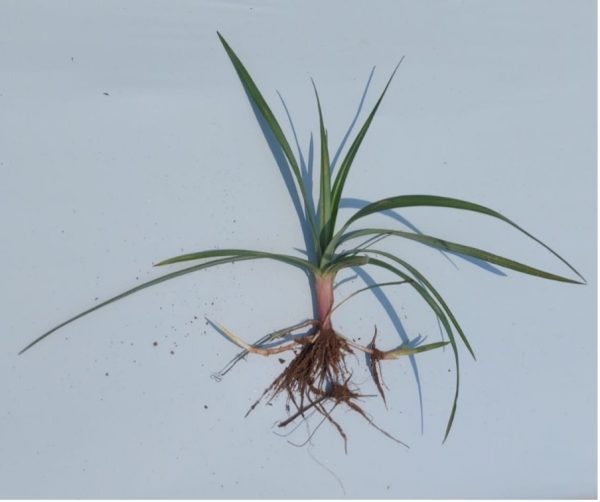
Figure 4. Yellow nutsedge plant and rhizomes
Nutsedge belongs to the Cyperaceae family and is common during the spring/summer season. Leaves are basal, flat, V-shaped, and usually longer than the stem. Common types in Alabama are yellow (Cyperus esculentus) and purple (Cyperus rotundus).
Yellow nutsedge leaves (figure 4) are often longer than the stems, and branches are straw-colored to brown. Purple nutsedge leaves are often shorter than the stems and have reddish, purple, or brown branches.
Nutsedge reproduces through tubers and rhizomes in the soil; yellow nutsedge also can reproduce from seed. Tubers and rhizomes can rapidly spread across the field and lie dormant in the soil for more than 10 years. Because of this, nutsedge control in infested fields is difficult and may take years.
Nutsedge plants develop tubers in late summer and early fall when rainfall events are more frequent. They grow faster in areas with high soil moisture availability; therefore, proper irrigation scheduling of the cash crop is key to managing this weed. Removing the leaves in July and August can help to prevent tuber formation.
Morning Glory (Ipomoea spp.)
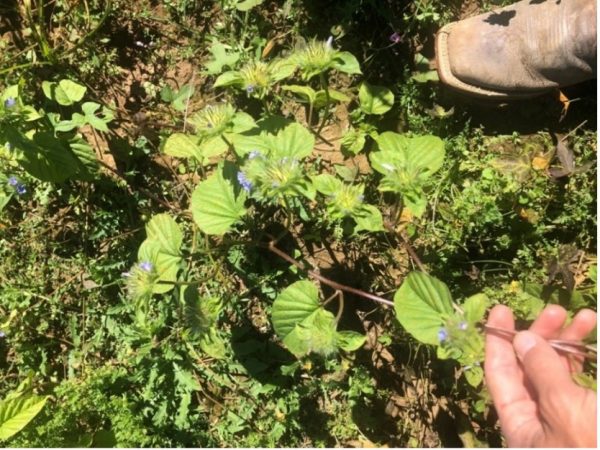
Figure 5. Morning glory
Morning glory (figure 5) is a summer weed dominant in south Alabama. It belongs to the Convolvulaceae family, the same family as the sweet potato. Alabama’s more common morning glory varieties are ivyleaf, tall, pitted, and entire leaf.
Morning glory leaves have a heart shape and can grow 3 to 5 inches along the vine. Flowers are funnel shaped and typically blue, purple, or white. It is common to see seed pods at the base of the flowers. A single plant can produce 5,000 to 15,000 seeds.
Although considered a problem for all vegetable crops, morning glory is more challenging for crops grown in trellis systems, such as tomato, pepper, eggplant, and cucumber. This is primarily due to vine tendrils, which enable the weed to climb the trellis and compete with vegetable crops for sunlight.
Morning glory grows best in moderately fertile and well-drained soil. Organic control can be achieved with bioherbicides and plastic mulching systems, which can reduce the sprout of seeds. Cover crop alone is not effective in reducing morning glory germination and establishment.
Sicklepod (Senna obtusifolia)
Sicklepod belongs to the Fabaceae family, the same family as soybeans, peas, and peanuts. It can grow up to 3 to 4 feet long and has small, green leaves rounded at the edges (figure 6). Flowers are yellow, have five petals, and develop sickle-shaped pods that produce 4- to 8-inch long seeds.
Sicklepod grows best in sunlight with soil moisture availability. Important control strategies include cover cropping and sicklepod plant removal before pods form.
- Figure 6. Sicklepod plant
- Figure 7a. Horse purslane
- Figure 7b. Horse purslane
Horse purslane (Trianthema portulacastrum)
Horse purslane is an annual herbaceous weed that belongs to the Aizoaceae family. Leaves are green, broad, and oval shaped. Flowers are small, white, and surrounded by purple color. The round and solid stems are weakly branched at first and later become prostrate. Horse purslane can grow horizontally up to 5 feet. Stems are succulent and hairy, allowing the plant to form a green carpet on top of the soil.
Horse purslane develops best in wet soils, such as swamps, streams, roadsides, cropland, and other disturbed areas. Mechanical strategies or chemical and biological products can achieve control. Mechanical weed control methods include the use of anything from hand tools to sophisticated tractor-driven or self-propelled devices to hand hoeing. Most recently, fungal pathogens’ use has been accepted as a safe, environmentally friendly, and effective form of biological control that minimizes the risks associated with herbicides.
Carpetweed (Mollugo verticillata)
Carpetweed belongs to the Molluginaceae family. As the name implies, carpetweeds grow over an area of up to 2 feet, forming a low-growing mat. The leaves are green and elongated. Flowers are small and white, produced in clusters of two to five flowers in the axils of the leaves. The plant produces small, egg-shaped fruit with a three-part capsule containing bright orange-red to orange-brown, kidney-shaped seeds.
Like goosegrass, carpetweed has branched roots that can root along the stems at any point where a node meets the soil. Carpetweed is a typical weed of sandy soils; it grows best in areas with high humidity and sunlight. Mechanical control of carpetweed is essential in organic vegetable production, and plastic mulching systems effectively suppress the spread of this weed in the field.
Acknowledgments
The United States Department of Agriculture funded the study via the National Institute of Food and Agriculture and the Organic Transitions Program (#2021-04817, “The Divergent Paths of Organic Transition: Best Management Practices for Initial Years of Organic Vegetable Fields in Southeastern U.S.”).
References
Breeden, G. K., and J. T. Brosnan. 2019. Goosegrass (Eleusine indica). The University of Tennessee Extension Bulletin W170.
CABI Invasive Species Compendium. Cabi.org. Accessed March 2022.
Cai, X., and M. Gu. 2016. “Bioherbicides in Organic Horticulture: A Review.” Horticulturae 2 (3).
Kumar, V., and R. K. Aneja. 2016. “Management of Horse Purslane (Trianthema portulacastrum L.): An Overview.” Research Journal of Botany 11: 25–32.
Mohler, C. L., J. R. Teasdale, and A. DiTommaso. 2021. Manage Weeds on Your Farm: A Guide to Ecological Strategies. Handbook series 16.
Sholedice, F., and M. Renz. 2006. “Yellow and Purple Nutsedge: Ornamental and Turf Guide.” http://aces.nmsu.edu/ces/plantclinic/documents/nutsedges-w-12.pdf.
Wilen, C. A., M. E. McGiffen, and C. L. Elmore. 2010. “Nutsedge: Integrated Pest Management for Home Gardeners and Landscape Professionals.” University of California IPM Publication 7432.
 Andre da Silva, Extension Specialist, Assistant Professor, Commercial Horticulture; Sthefani Oliveira, Post Doctoral Research Associate, Horticulture; Zachary Jones, Research Associate, Horticulture; and Steve Li, Associate Professor, Crop, Soil, and Environmental Sciences, all with Auburn University
Andre da Silva, Extension Specialist, Assistant Professor, Commercial Horticulture; Sthefani Oliveira, Post Doctoral Research Associate, Horticulture; Zachary Jones, Research Associate, Horticulture; and Steve Li, Associate Professor, Crop, Soil, and Environmental Sciences, all with Auburn University
New September 2022, Growing Organic Vegetables in Alabama: Know Your Weeds, ANR-2923

